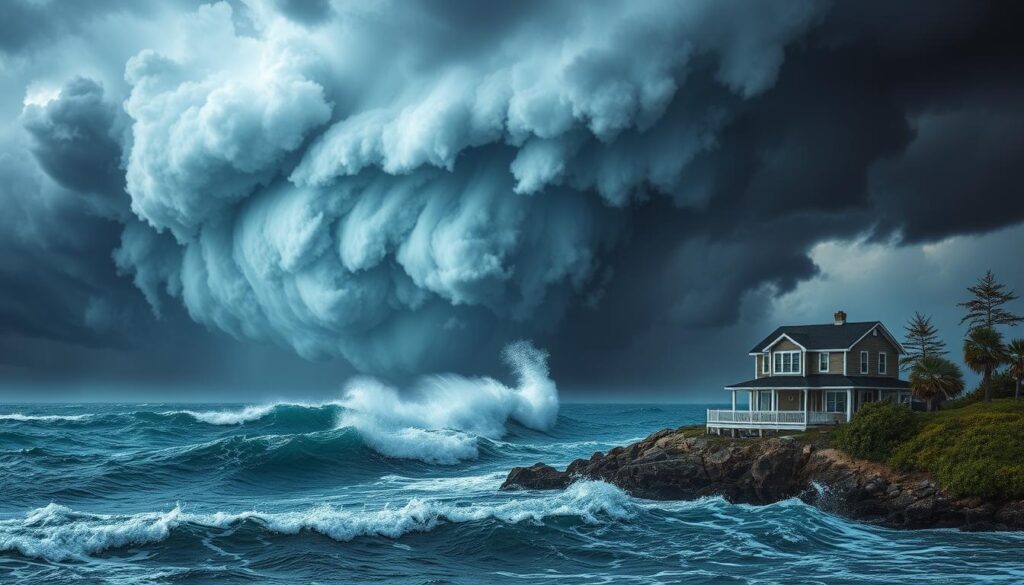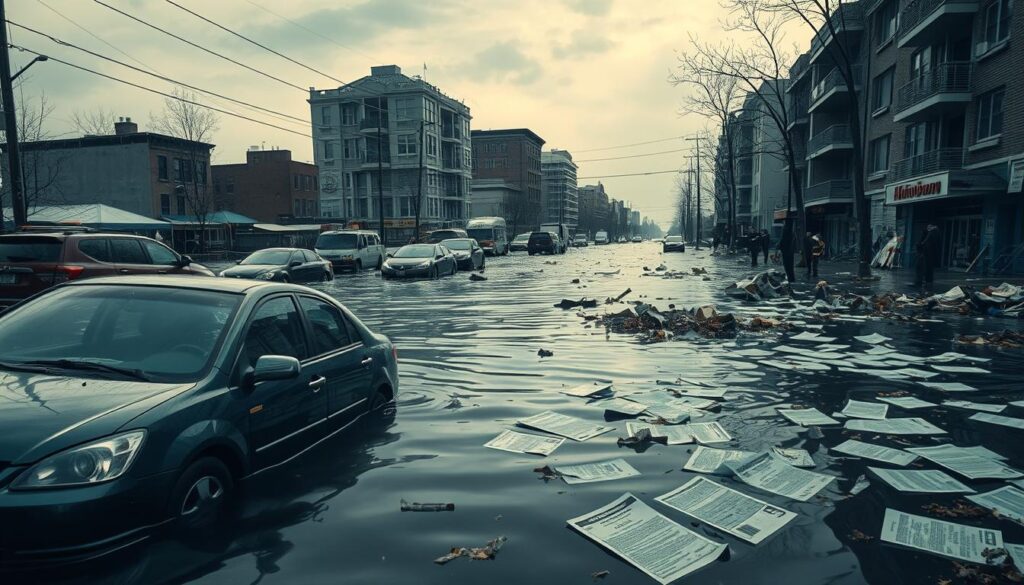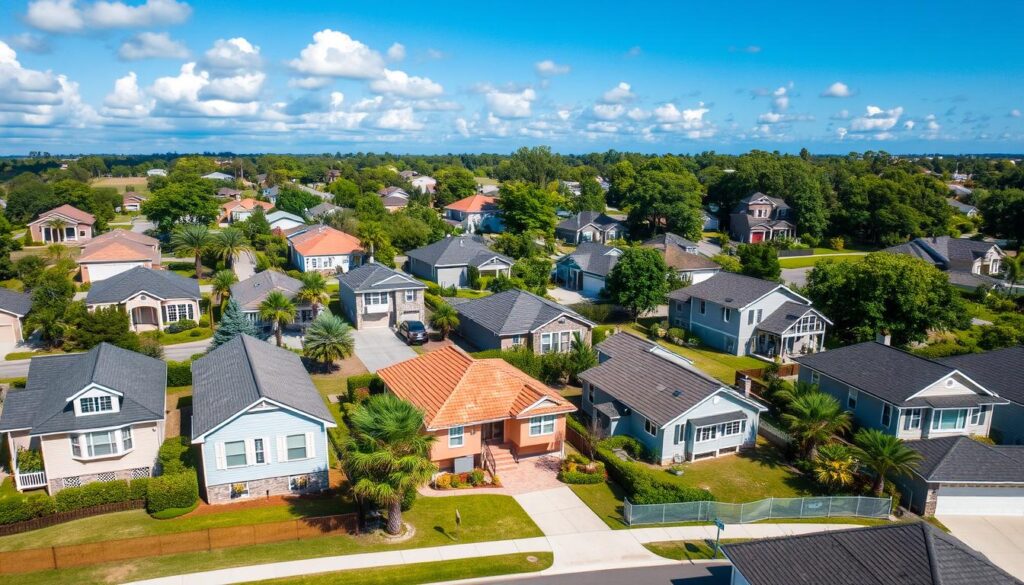In 2022, the United States saw 18 weather and climate disasters, each costing over a billion dollars. This shows how important it is to have good home insurance coverage for natural disasters. With climate change affecting our planet, it’s key for homeowners to get the right insurance for their homes.
This guide will help me understand what I need for insurance against natural disasters. We’ll look at what home insurance usually covers, the different types of coverage, and how to check if my policy is still good.
A serene suburban neighborhood, showcasing a variety of houses with visible natural disaster preparedness features like reinforced roofs, raised foundations, and storm shutters, surrounded by lush greenery and blue skies, with subtle hints of weather resilience, such as flood barriers and solar panels.
Key Takeaways
- The U.S. saw 18 weather-related disasters worth billions of dollars in 2022, underscoring the rising threat of natural disasters.
- Homeowners should consider comprehensive home insurance to protect against potential damages.
- Flood insurance is often excluded in standard policies, making it crucial for those in flood-prone areas.
- Regularly reviewing and updating home insurance policies is essential to stay protected against emerging risks.
- Different types of insurance are available for various disasters, including hurricanes, earthquakes, floods, and wildfires.
Understanding Natural Disasters and Insurance Needs
Natural disasters can happen anytime, causing a lot of damage and financial loss. It’s crucial to have the right insurance to protect my home and money. Standard homeowners insurance covers fires, theft, and vandalism but not natural disasters.
Places prone to hurricanes, floods, or earthquakes need extra insurance. This is because these areas face higher risks.

When I look at my insurance, I think about the risks in my area. Coastal areas, for example, need strong coverage because of severe weather. Checking my policy shows what’s covered and what’s not.
The typical price of homeowners insurance in the United States is $2,230 a year. But in places like Florida or Louisiana, it can be over $5,000. This is because of the higher risks from natural disasters.
Insurance companies also offer educational resources to help understand policies better. Talking to insurance experts gives me advice specific to my situation. These steps help keep my home safe from natural disasters and keep my finances stable.
A dramatic seascape portraying a powerful hurricane approaching a coastal home, with dark swirling clouds and towering waves, showcasing the vulnerability of property against natural disasters, while incorporating elements of insurance symbols subtly in the landscape, such as a shield or umbrella blended into the environment.
Key Facts About Natural Disasters
Natural disasters can have a big financial hit on homeowners. Knowing how they affect us can help us choose better insurance and get ready. In recent years, the costs of these disasters have been huge, showing we need good ways to manage risks.
With climate change making disasters more common and severe, it’s key to understand how home insurance is changing.
The Financial Impact of Natural Disasters
The financial hit from natural disasters has been huge. For example, in 2020, the damage costs were a staggering $74.4 billion. The top ten states hit hardest are especially telling:
| State | Total Cost (in billions) |
|---|---|
| Alabama | $4.26 |
| Missouri | $3.38 |
| Texas | $2.03 |
| Oklahoma | $2.01 |
| Illinois | $1.21 |
| Ohio | $0.69 |
| Mississippi | $0.59 |
| Kansas | $0.56 |
| Georgia | $0.51 |
| Arkansas | $0.40 |
Having enough insurance is crucial, especially since basic policies might not cover all damage. For example, flood damage needs a special policy from the National Flood Insurance Program (NFIP).
Climate Change and Increasing Risks
Climate change is making natural disasters worse. Severe weather and rising sea levels are big concerns. Homeowners in risky areas face higher insurance costs.
Between 2020 and 2023, home insurance prices went up a lot. This shows the real risk and how insurance is changing.
A big part of the price increase is due to the growing risk. Getting ready for these disasters means we need insurance that fits our needs and risks.

A dramatic scene depicting the financial aftermath of a natural disaster, featuring a flooded urban street with submerged cars, damaged buildings, scattered debris, and insurance papers floating in the water, with a somber sky overhead and distant silhouettes of emergency responders assessing the situation.
What is Home Insurance Coverage?
It’s important to know what my home insurance covers. A typical policy protects against fires, theft, and some natural disasters. Damage to my house and personal belongings is also covered.
Some natural disasters aren’t covered by standard policies. For instance, specific insurance is required for earthquakes and floods. One source of flood insurance is the National Flood Insurance Program (NFIP).
Homeowners might choose extra coverage based on their location. In California, earthquake insurance is available. Most policies cover damage from fires and fallen trees. But, wind damage in hurricane-prone areas is often not included.
Some companies and federal programs offer special policies for certain risks. For example, parametric insurance pays out based on earthquake intensity. Reviewing my policy helps me understand what’s covered and what’s not. I can then add extra coverage for specific risks in my area.
Home Insurance Coverage for Natural Disasters
It’s crucial to know about home insurance for natural disasters to protect my assets. There are many options, and understanding what’s covered helps me choose wisely. A good policy might include special coverage for different needs. This article will explain what’s covered and the common disasters that are usually included.
Types of Coverage Included in Policies
Home insurance policies usually have several types of coverage. These include:
- Dwelling Coverage: This protects my home’s structure from damage like fire, wind, and hail.
- Personal Property Protection: It covers my belongings inside the home if they get damaged or stolen.
- Liability Protection: This helps if someone gets hurt on my property.
- Additional Living Expenses: If my home is not safe to live in, this covers temporary housing costs.
The HO-3 Special Form is a common policy that covers many perils, unless they’re excluded. Knowing what’s covered helps me decide if I need extra insurance, especially in high-risk areas.
What Disasters Are Typically Covered?
Home insurance often covers these natural disasters:
- Fire and smoke damage
- Windstorms, including tornadoes
- Severe storms and hail
- Volcanic eruptions
However, there’s a big gap for disasters like floods and earthquakes. These usually need extra policies or endorsements because they’re often not covered in standard policies. The National Flood Insurance Program (NFIP) requires a different policy for flood damage, for instance. Knowing what’s not covered helps me get the right insurance for my area’s risks.
Types of Insurance for Specific Disasters
It’s key to know the different insurance types for natural disasters to protect my home. Each disaster has its own coverage needs. So, picking the right policies is crucial for me.
Hurricane Insurance Coverage
Homes near the coast need hurricane insurance. This coverage includes windstorm protection. It’s important to check my policy to make sure it covers me well during hurricane season.
Earthquake Home Insurance
Earthquake insurance is a must for those in seismic zones. Many forget about this coverage, thinking they’re safe. Getting an earthquake insurance quote is wise, even if I’m not in a high-risk area. Typically, policies for this are distinct from those for regular homeowners insurance.
Flood Insurance Policies
The most frequent calamity in the United States is flooding. The first 30 days of coverage for flood insurance are a waiting period. This is something to think about when planning. NFIP policies cover sewer and drain backups from flooding, but not all policies do. I need to make sure my flood insurance fits my risks, especially in high-risk areas.
Wildfire Insurance Coverage
Wildfire insurance is vital for those in wildfire-prone areas. It protects against fire damage. Many states offer special programs based on local risks, helping me understand what coverage I need.
| Type of Insurance | Key Features | Considerations |
|---|---|---|
| Hurricane Insurance Coverage | Includes windstorm protection | Higher deductibles typically apply |
| Earthquake Home Insurance | Protection against seismic events | Usually requires a separate policy |
| Flood Insurance Policies | Covers damages from flooding | 30-day waiting period before coverage begins |
| Wildfire Insurance Coverage | Protection against fire damage | Higher coverage needed in wildfire-prone areas |
Reviewing Your Home Insurance Policy
It’s important to regularly check my home insurance policy. This makes sure it still meets my needs and offers enough protection. Knowing what’s not covered helps me spot any gaps that could leave me at risk.
Many policies don’t cover natural disasters like floods or earthquakes. I need separate policies for full protection. It’s key to know this to avoid unexpected costs when disaster hits.
Understanding Exclusions and Limitations
Many homeowners, including me, might not know what’s not covered in their policies. For example, home insurance usually covers fires or wind damage but not floods. Homeowners in flood-prone areas need a separate flood policy.
Disasters like earthquakes or mudslides also need extra coverage. Knowing these limits can save me from financial trouble when things get tough.
Updating Your Coverage for New Perils
Life changes and home updates can bring new risks. If I get new valuable items or change my home, I need to check my insurance. This ensures my coverage keeps up with my new situation.
Being proactive with my policy helps me face new threats. It keeps my home and mind safe from natural disasters.
How to Choose the Best Home Insurance for Natural Disasters
Choosing the right coverage starts with knowing my property’s risks. This includes where I live and the disasters that might hit. Understanding these risks helps me pick the right policies for my home and stuff.
Assessing Your Risk Factors
Don’t overlook risk assessment for insurance. Think about these things:
- Geographical location: Is my home in an area prone to floods, hurricanes, or earthquakes?
- Adverse weather patterns: What types of extreme weather events frequently occur nearby?
- Historical data: Have similar homes in my region suffered damage in past disasters?
Knowing these helps me figure out what coverage I really need.
Comparing Policy Options
After figuring out my risks, I need to look at different policies. I should check things like:
| Insurance Provider | Type of Coverage | Premium Costs | Deductibles |
|---|---|---|---|
| State Farm | Comprehensive Fire & Flood | $1,200/year | $1,000 |
| Allstate | Earthquake & Hurricane Protection | $1,500/year | $2,000 |
| Geico | Standard Policy with Add-Ons | $1,000/year | $500 |
| Nationwide | Specialty Disaster Coverage | $1,800/year | $3,000 |
This comparison helps me see what each policy offers. I can then choose the best home insurance for natural disasters, keeping my property safe.
Preparing for Natural Disasters: Action Steps
It’s crucial to take proactive steps for emergency preparedness. Creating a detailed plan is key. This plan should include emergency kits and home reinforcement techniques to protect your family.
Emergency Preparedness Kits
An emergency preparedness kit is essential. The American Red Cross says it should cover a family’s needs for three days. This includes:
- Non-perishable food items
- Water (one gallon per person per day)
- Flashlights and batteries
- First aid supplies
- Important documents (insurance information, identification)
- A battery-operated or hand-crank radio
Since 77% of Americans lack a plan, it’s vital for your family’s safety. The U.S. government also suggests having cash, as electronic payments might fail during emergencies.
Home Reinforcement Techniques
Strengthening your home is crucial. You can employ a variety of methods, including:
- Installing storm shutters for wind resistance
- Securing outdoor furniture and items
- Using fire-resistant materials in construction
These methods improve your home’s strength and protect it from disasters. Over 40% of small businesses don’t reopen after disasters, so investing in home reinforcement is important.
Claiming Damages after a Natural Disaster
Dealing with a natural disaster’s aftermath can be tough. It’s key to know how to handle insurance claims to recover well. Before I start claiming damages, I need to take some important steps. These steps help make the process smoother and ensure I get the right compensation.
Steps to Take Before Filing a Claim
Filing a successful insurance claim needs good preparation. Here are the main steps before filing a claim:
- Document all damages with photos and notes.
- Contact my insurance provider quickly to report the loss.
- Review my policy to know what’s covered and what’s not.
- Gather receipts and proof of ownership for damaged or lost items.
- Keep records of all talks with the insurance company.
- Know the deadlines for filing claims to avoid denials.
Understanding the Claim Process
Understanding the insurance claim process helps avoid problems. The steps usually are:
- Initial claim report: I file a claim with my insurance company.
- Claim assessment: An insurance adjuster checks the damages.
- Estimate review: I get an estimate of the claim amount.
- Claim decision: The insurer decides if to approve or deny the claim.
- Payment processing: If approved, I wait for payment, which may need proof of repairs.
Knowing the steps before filing a claim is crucial after a natural disaster. Understanding the insurance claim process helps me fight for my rights. It ensures I get the compensation I deserve.
Conclusion
Home insurance is more crucial than ever, with natural disasters happening more often and being more severe. In 2023, insurers covered only 70 percent of natural disaster losses. This shows we need better coverage to avoid financial shocks.
Knowing the risks, like hurricanes and wildfires, helps me choose the right insurance. By picking a policy that fits the threats, I’m ready for anything. It’s also key to keep my policy up to date to stay ahead of new risks and options.
Exploring options like parametric insurance and community-based models can also help. By doing this, I protect my home and help others prepare for disasters. This way, I’m ready for whatever comes next.
FAQ
Which kinds of natural disasters are normally covered by regular policies for home insurance?
Standard home insurance usually covers fires, thefts, and windstorms. But, floods and earthquakes need their own policies. Standard coverage frequently excludes them.
How can I make sure my house is hurricane-proof?
To guard your home against hurricanes, get specialized hurricane insurance. This includes windstorm protection. Also, use storm shutters and secure outdoor items to reduce damage risks.
Do I need separate insurance for floods and earthquakes?
Indeed, flood and earthquake damage are not covered by typical homeowners insurance. So, you’ll need separate policies for these risks to have full disaster insurance.
What should I do if I need to file a claim after a natural disaster?
First, document all damage well. Then, call your insurance provider to report the loss. Knowing the claim process and having your paperwork ready can make recovery easier.
How frequently should my house insurance policy be reviewed?
Review your policy yearly or after big life changes or home updates. This ensures your coverage matches your current risks and needs.
What is comprehensive home insurance coverage?
Comprehensive coverage safeguards your house and possessions from a variety of threats. It’s key to include specific disaster coverage not in standard policies.
What are some effective home reinforcement techniques for natural disasters?
To strengthen your home, install storm shutters and use fire-resistant materials. Also, secure outdoor items to lessen damage from storms and wildfires.
How do I assess my property’s risk factors for natural disasters?
Look at your location, local climate, and past disaster data. This helps you pick the right insurance options for your property.
What are the financial implications of natural disasters?
Every year, natural calamities might cost more than $1 billion. Good insurance helps cover these costs and keeps your finances stable.
What does a typical homeowners insurance policy cover?
Typical policies cover your home, belongings, and liability. But, you might need extra for damage from natural disasters.



